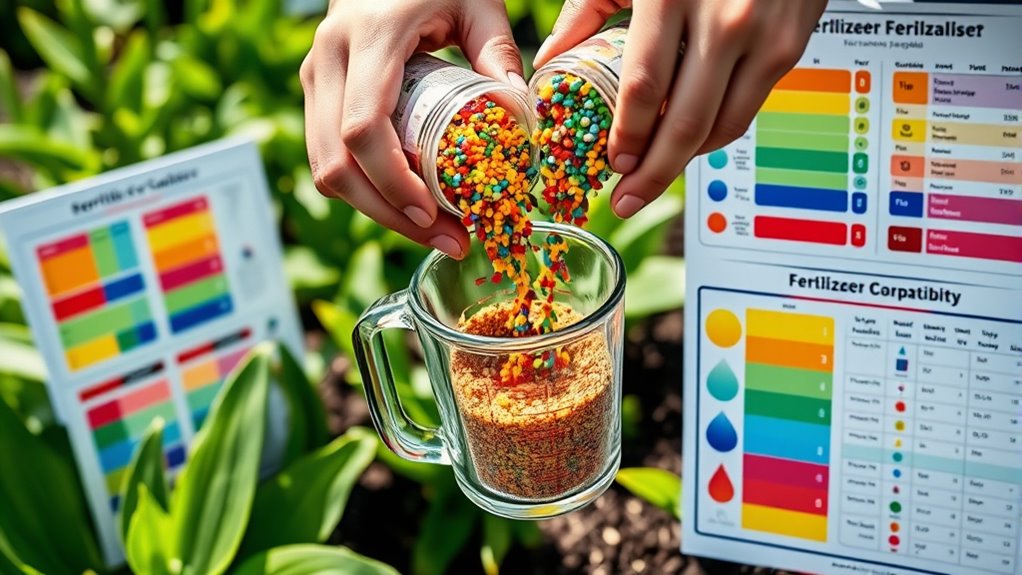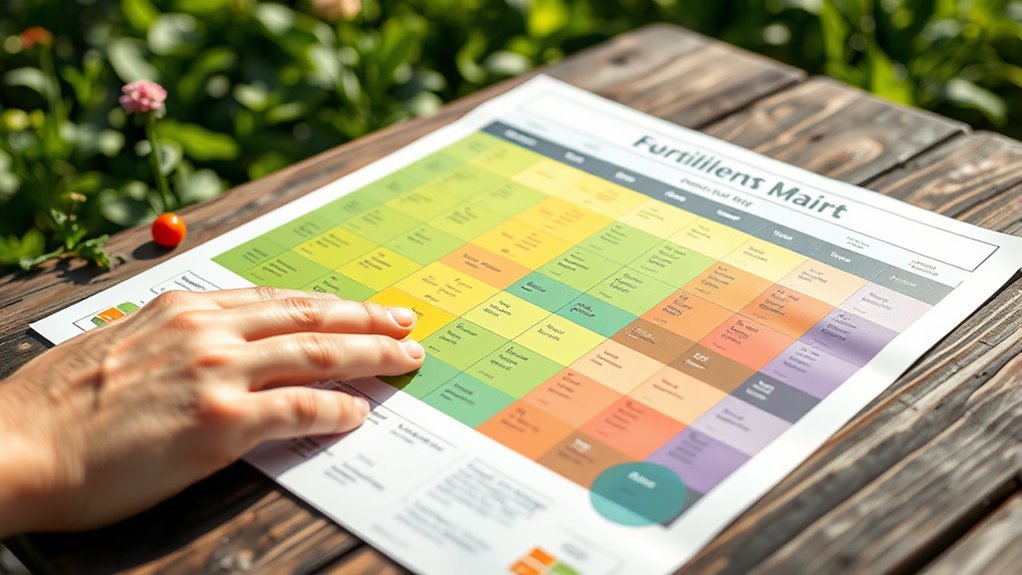Fertilizer compatibility charts help you choose safe combinations that promote healthy plant growth and prevent nutrient lockout or damage. They use color codes and symbols indicating whether fertilizers can be mixed safely or need caution. Understanding these guides guarantees you avoid harmful reactions and optimize soil health. By following proper interpretations and considering your soil conditions, you can make better fertilization decisions. If you want to master the details, you’ll find useful tips right ahead.
Key Takeaways
- Compatibility charts use color codes and symbols to indicate safe, cautious, or incompatible fertilizer combinations.
- Always verify compatibility before mixing fertilizers to prevent nutrient lockout and soil or plant damage.
- Use soil tests and label guidance alongside charts for accurate fertilizer compatibility assessment.
- Organic fertilizers and soil amendments require specific considerations for compatibility based on soil pH.
- Reliable sources like university extension and research institutions provide trusted and up-to-date compatibility charts.
Understanding Fertilizer Compatibility Charts

Understanding fertilizer compatibility charts is essential for ensuring your plants receive the right nutrients without causing harm. These charts help you determine which fertilizers work well together, especially when considering soil pH and organic fertilizers. Soil pH affects nutrient availability, so mixing incompatible fertilizers can lead to nutrient lockout or deficiencies. Organic fertilizers, like compost or manure, often have different nutrient profiles, making compatibility vital to avoid adverse reactions. Additionally, proper understanding of fertilizer chemistry ensures you apply the right products in the right combinations, leading to healthier plants and more successful gardening. By consulting these charts, you can select fertilizers that complement each other, promoting healthy growth without risking chemical interactions that could damage your plants.
Why Compatibility Matters for Healthy Plants

When fertilizers aren’t compatible, your plants can experience nutrient lockout, which prevents them from absorbing essential nutrients. This can lead to uneven or stunted growth, making your plants weaker overall. Ensuring compatibility helps promote balanced growth and keeps your plants healthy and thriving. Incorporating practices like proper soil preparation can further enhance nutrient uptake and overall plant health. Additionally, understanding fertilizer interactions is crucial to prevent adverse chemical reactions that could harm your plants. Being aware of plant-specific needs ensures that the fertilizers used are suitable for the particular species you are cultivating.
Prevents Nutrient Lockout
Ever wonder why mixing incompatible fertilizers can harm your plants? When you combine fertilizer types that don’t suit your soil pH, nutrients can become locked out, preventing plants from absorbing what they need. Incompatible mixes can cause chemical reactions that create insoluble compounds, leading to nutrient lockout. This means essential elements like nitrogen, phosphorus, and potassium stay unavailable, stunting growth and reducing yield. Using compatible fertilizers ensures the right balance and prevents these issues. Always check compatibility charts to confirm that your fertilizer combinations won’t interfere with each other. Proper mixing helps maintain soil health and ensures your plants get a steady supply of nutrients, avoiding nutrient lockout and promoting vigorous, healthy growth. Additionally, understanding soil nutrient interactions can further improve your fertilization strategies. Being aware of product compatibility through detailed charts can help you avoid unintended chemical reactions that hinder plant development. Recognizing application timing also plays a crucial role in optimizing nutrient uptake and preventing deficiencies.
Promotes Balanced Growth
Using compatible fertilizers is essential for promoting balanced growth in your plants because it guarantees they receive a steady and harmonious supply of nutrients. When fertilizers work well together, they help maintain optimal soil pH levels, which is crucial for nutrient absorption. Organic fertilizers, when compatible, support healthy root development and overall plant vigor without disrupting soil chemistry. Compatibility ensures plants grow uniformly, avoiding issues like nutrient imbalances or deficiencies. Additionally, understanding best CAD papers can aid in designing efficient fertilizer application equipment that minimizes waste and maximizes effectiveness. You should also consider:
- Avoiding over-fertilization that can upset soil pH
- Using organic fertilizers for sustainable growth
- Combining nutrients that complement each other
- Preventing nutrient lockout caused by incompatible mixes
- Supporting soil health for long-term plant vitality, which is vital for soil chemistry balance.
Common Symbols and Color Codes in Charts

Understanding the color codes and symbols on charts helps you quickly identify compatible fertilizers. Each color and symbol carries specific meanings that make reading the chart easier and more accurate. Learning these basics will improve your ability to interpret the information effectively. Familiarity with fertilizer compatibility charts can help prevent costly mistakes and ensure optimal plant health. Additionally, recognizing relationship indicators can aid in understanding how different nutrients interact within your gardening setup. Recognizing nutrient interactions is essential for creating balanced and effective fertilization plans.
Color Coding Significance
Color coding in fertilizer compatibility charts provides quick visual cues to help you interpret the information efficiently. It highlights compatibility, caution, or incompatibility at a glance, saving you time and reducing errors. The colors often represent specific meanings—green indicates safe combinations, yellow warns of caution, and red signals incompatibility. Understanding these color codes enhances your decision-making, ensuring ideal plant health. Additionally, familiarizing yourself with color accuracy in projectors can also improve your overall home environment by creating a more relaxing space.
Symbol Meanings Explained
Symbols and color codes on fertilizer compatibility charts provide quick, clear signals about how different nutrients or products interact. To interpret these visuals accurately, you should familiarize yourself with the symbol legends, which explain what each symbol represents—such as compatibility, incompatibility, or caution. Color meanings also play an essential role; for example, green may indicate safe combinations, while red signals potential conflicts. Understanding these symbols and color codes helps you quickly assess whether fertilizers can be mixed or should be applied separately. Paying attention to these key elements ensures you avoid harmful reactions and optimize nutrient delivery. Mastering the symbol legends and color meanings allows you to make informed decisions, saving time and preventing costly mistakes in your fertilization practices.
Chart Interpretation Tips
When interpreting fertilizer compatibility charts, paying close attention to common symbols and color codes is essential for quick, accurate assessments. These visual cues help you identify compatible fertilizers and avoid negative interactions. For example, color codes often indicate compatibility levels, while symbols may show specific nutrient relationships or restrictions. To make the most of these charts, keep these tips in mind:
- Understand what each symbol represents, especially regarding soil testing results and nutrient deficiencies.
- Recognize color codes indicating compatibility, caution, or incompatibility.
- Cross-reference symbols with your soil test data to address nutrient deficiencies effectively.
- Use color cues to quickly identify suitable fertilizer combinations.
- Always double-check symbols and colors to prevent misinterpretation, ensuring optimal plant health and avoiding fertilizer conflicts.
- Familiarizing yourself with arcade machines can also help you understand how different systems and hardware interact, which is useful when managing or troubleshooting complex charts and data.
- Additionally, understanding sound healing science can enhance your ability to interpret visual information by recognizing patterns and frequencies that influence perception and decision-making.
- Developing awareness of spiritual symbolism can help you better interpret subtle cues and signs that may appear in visual data or visual representations.
Types of Fertilizers and Their Interactions

Understanding the different types of fertilizers and how they interact is essential for achieving healthy plant growth. Soil amendments, like compost or lime, improve soil structure and nutrient availability, while organic fertilizers, such as manure or fish emulsion, supply nutrients naturally. These fertilizers can have positive interactions when used correctly, enhancing nutrient uptake and promoting soil health. However, combining certain types improperly may lead to nutrient lockout or imbalances, reducing effectiveness. For example, mixing high-phosphorus fertilizers with soil amendments that alter pH can harm plants. It’s vital to understand how organic fertilizers release nutrients slowly over time and how soil amendments influence nutrient availability. Additionally, understanding fertilizer interactions and their impact on soil chemistry can help prevent nutrient deficiencies or toxicities. Proper knowledge of nutrient release rates ensures that fertilizers are applied at appropriate times for optimal plant uptake. By knowing these interactions, you can optimize fertilizer use, avoid conflicts, and support vigorous, healthy plant growth.
How to Read a Fertilizer Compatibility Chart

Fertilizer compatibility charts are valuable tools that help you determine which fertilizers can be safely combined to promote healthy plant growth. To read a chart effectively, start by checking the labels for symbols indicating compatibility or caution. Pay attention to soil pH, as it influences nutrient availability and can affect nutrient synergy. Look for color codes or symbols that signal whether fertilizers mix well or should be used separately. Keep in mind that some combinations may cause nutrient lockout or toxicity, so always double-check the chart before blending. Remember:
- Compatibility symbols indicate safe combinations
- Soil pH impacts nutrient availability
- Nutrient synergy enhances plant growth
- Cross-reference labels for clarity
- Avoid mixing incompatible fertilizers to prevent damage
- Understanding the benefits of practicing stillness can improve your ability to interpret and make informed decisions based on compatibility charts.
Tips for Safe Mixing of Fertilizers

Always check fertilizer compatibility before mixing to prevent harmful reactions. Use proper dilution ratios to keep solutions safe for your plants and equipment. Keep an eye out for any signs of chemical reactions, like clumping or discoloration, to address issues early.
Check Compatibility First
Before mixing fertilizers, it’s essential to check their compatibility to prevent harmful reactions or clogged equipment. Always verify compatibility using charts or testing methods before combining different products. This step helps avoid issues that could impair pest management efforts or disrupt soil health. Conduct soil testing to understand nutrient levels and avoid over-fertilizing or creating chemical reactions. Remember, incompatible fertilizers can cause clumping, precipitates, or gas release, which damage equipment or harm plants.
- Use compatibility charts to confirm safe combinations
- Test soil conditions regularly for ideal results
- Avoid mixing fertilizers with incompatible pH levels
- Be cautious with liquid and dry fertilizers combined
- Consult experts if unsure about specific combinations
Use Proper Dilution Ratios
Proper dilution ratios are essential to guarantee safe and effective fertilizer application. Using the correct mix prevents root damage and ensures nutrients are available for plant growth. When working with soil amendments or organic fertilizers, always follow manufacturer instructions and test small batches first. A common ratio is 1 part fertilizer to 10 parts water, but it varies based on product type. To help you stay on track, refer to this quick guide:
| Fertilizer Type | Dilution Ratio |
|---|---|
| Organic fertilizers | 1:10 (fertilizer:water) |
| Soil amendments | Follow label instructions |
Always double-check ratios before mixing, and avoid over-concentrating to prevent plant stress or soil imbalance. Proper dilution promotes healthy plants and safe application.
Observe for Signs of Reactions
When mixing fertilizers, it’s crucial to watch for visible reactions that can indicate incompatibility or potential problems. Signs like clumping, cloudiness, or bubbling may suggest a chemical reaction that could harm your plants. Monitoring your plants for stress symptoms after application is equally important. If you notice leaf curling, yellowing, or wilting, it could be a sign of fertilizer imbalance or reaction.
To stay safe, remember:
- Always observe the mixture for cloudiness or separation
- Check for bubbling or foaming during mixing
- Watch for unexpected color changes
- Monitor plants closely for stress symptoms
- Discontinue use if any adverse reactions occur
Being attentive helps prevent plant stress and guarantees safe, effective fertilizer application.
Troubleshooting Compatibility Problems

Even with careful planning, compatibility issues can arise when combining fertilizers. If you notice poor plant growth, leaf spotting, or unusual soil reactions, it’s time for troubleshooting. First, review your fertilizer labels and compatibility charts to identify potential conflicts. Sometimes, incompatible mixes can hinder pest prevention efforts, making plants more vulnerable. If a problem persists, consider testing your soil as a soil amendment to improve nutrient balance and reduce chemical reactions. Avoid mixing fertilizers that aren’t approved together, and always follow recommended application rates. Rinsing or flushing the soil can help if you suspect a reaction has occurred. Staying vigilant and adjusting your approach ensures healthy growth and prevents long-term soil damage.
Examples of Compatible and Incompatible Combinations

Knowing which fertilizer combinations work well together can prevent compatibility issues and promote healthy plant growth. Compatible combinations typically consider soil pH and the nature of fertilizers, especially organic options. For example, organic fertilizers like compost tea often blend well with mineral-based fertilizers without causing nutrient lockout. In contrast, mixing fertilizers with vastly different pH requirements can lead to poor nutrient uptake.
- Avoid combining high-phosphate fertilizers with alkaline soil, as it can cause nutrient imbalances.
- Compatible: using ammonium nitrate with soil pH around 6.0-7.0.
- Incompatible: mixing calcium nitrate with acidic soil, which can cause precipitation.
- Organic fertilizers generally work well together, but avoid combining them with synthetic products that alter soil pH unpredictably.
- Always test soil pH before mixing to guarantee compatibility.
Using Compatibility Charts in Garden Planning

Have you ever wondered how to guarantee your fertilizers work harmoniously in your garden? Compatibility charts help you plan effectively by showing which fertilizers and soil amendments combine well or cause issues. Use these charts to avoid harmful reactions that could harm plants or reduce pest control effectiveness. For example, mixing incompatible nutrients might block uptake or damage roots. Here’s a simple guide:
| Fertilizer Type | Compatible with | Not Compatible with |
|---|---|---|
| Nitrogen-based | Phosphorus | Calcium |
| Phosphorus | Potassium | Iron |
| Potassium | Soil amendments | Excessive organic matter |
Refer to these charts regularly to optimize plant health, improve soil conditions, and ensure pest control measures remain effective. Proper planning ensures a thriving, balanced garden.
Resources for Finding and Interpreting Charts

Finding reliable resources for fertilizer compatibility charts is vital to guarantee your gardening efforts are successful. These charts help you understand how different soil amendments interact and prevent issues like harmful pesticide interactions. To find trustworthy information, consider reputable sources such as university extension services, agricultural research institutions, and government websites. You can also consult industry publications and professional gardening organizations. Additionally, many online databases and apps offer detailed compatibility charts tailored to specific crops. When interpreting these charts, look for guidance on combining fertilizers with soil amendments and avoid combinations that could lead to pesticide interactions. Remember, accurate charts save you time, reduce waste, and promote plant health. Always verify the source to make sure you’re working with up-to-date, scientifically backed data.
Frequently Asked Questions
Can Compatibility Charts Be Used for Organic Fertilizers?
You might wonder if compatibility charts work for organic fertilizers. While they’re mainly designed for synthetic options, you can still use them as a general guide for organic considerations. Natural alternatives often require more careful mixing, so check compatibility charts to avoid adverse reactions. Always test small amounts first, and remember that organic fertilizers may need different handling, so use charts as a starting point for safe, effective application.
How Often Should I Update My Fertilizer Compatibility Charts?
You should update your fertilizer compatibility charts regularly to guarantee chart accuracy. Fertilizer testing helps identify any changes in formulations or nutrient availability, which can affect compatibility. By updating your charts after each testing session, you can avoid potential issues and guarantee ideal plant health. Keep in mind that as products evolve, frequent updates help you maintain reliable information, making your fertilization practices safer and more effective.
Are There Digital Tools for Real-Time Fertilizer Compatibility Checks?
Imagine having a supercomputer at your fingertips, instantly solving complex compatibility puzzles—that’s what digital tools for fertilizer compatibility checks offer. You can now perform real-time compatibility checks effortlessly, ensuring your plants get the perfect nutrients without guesswork. These innovative tools revolutionize plant care, saving you time and preventing costly mistakes. Embrace the future of gardening with digital solutions that make compatibility checks faster, smarter, and more accurate than ever before.
Do Compatibility Issues Vary Between Indoor and Outdoor Plants?
Compatibility issues do differ between indoor plants and outdoor gardening. Indoor plants often require gentler fertilizers because of limited space and sensitive roots, making them more prone to nutrient imbalances. Outdoor gardening involves larger soil volumes and exposure to weather, which can influence fertilizer interactions. You should always consider these differences when choosing fertilizers, ensuring that your indoor plants get the right nutrients without risking harm, and outdoor plants thrive in their environment.
What Are the Environmental Impacts of Mixing Incompatible Fertilizers?
Mixing incompatible fertilizers can cause serious environmental impacts. You might create soil contamination, harming beneficial microbes and reducing soil health. It can also lead to nutrient imbalance, which affects plant growth and increases runoff, polluting nearby water sources. By ensuring fertilizers are compatible, you help protect the environment, promote healthy plant development, and prevent long-term soil degradation. Always check compatibility to avoid these negative effects.
Conclusion
By mastering fertilizer compatibility charts, you reveal the secret to thriving plants and bountiful harvests. But beware—one wrong mix can turn your garden dreams into setbacks. Are you prepared to navigate these essential details? The next step could transform your gardening game forever. Stay alert, stay curious, and keep exploring—because the key to a lush, healthy garden might be closer than you think. Will you uncover the hidden secrets today?









